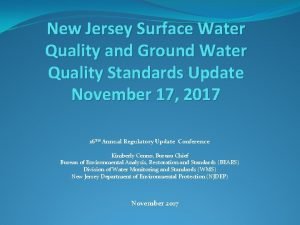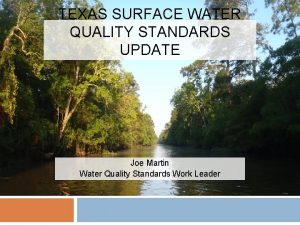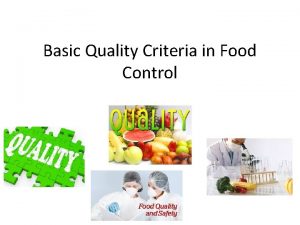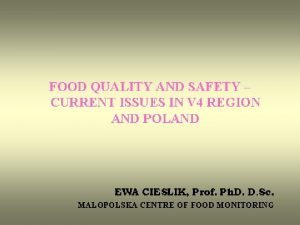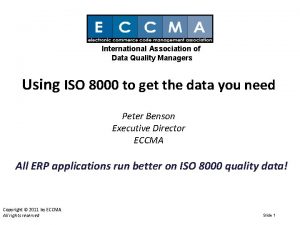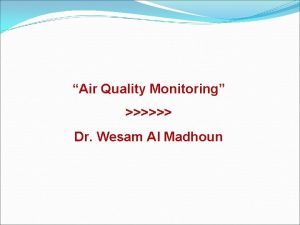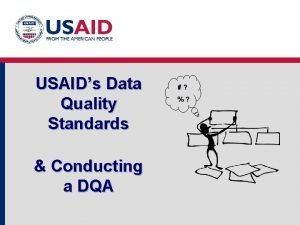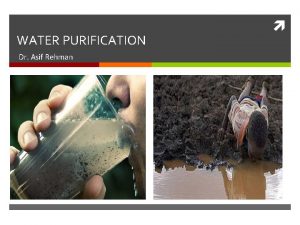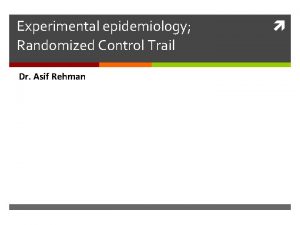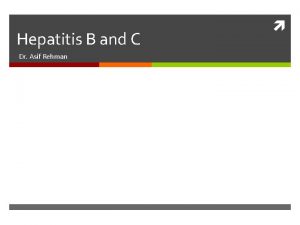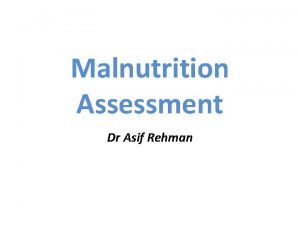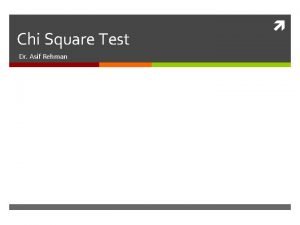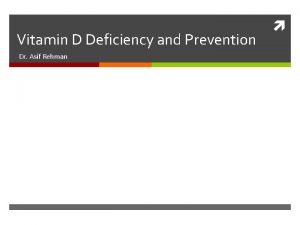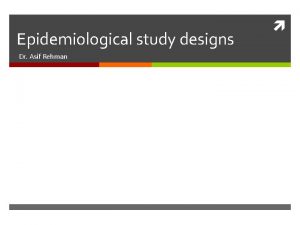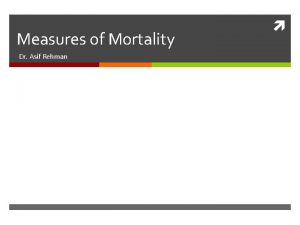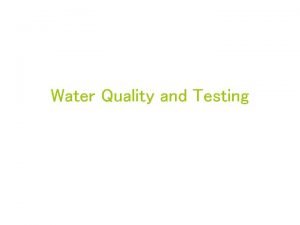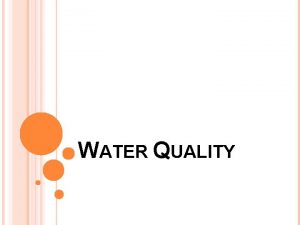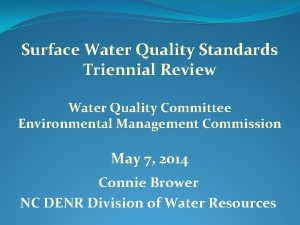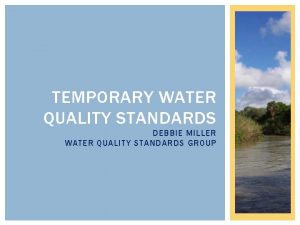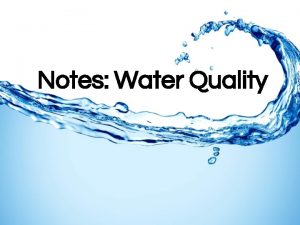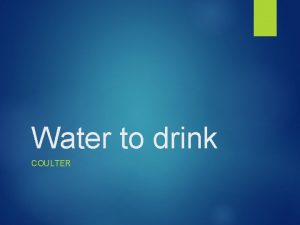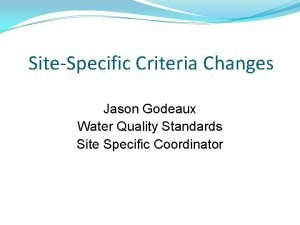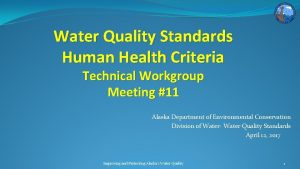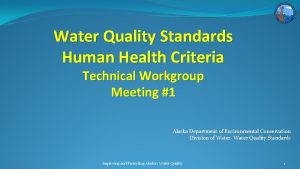WATER QUALITY CRITERIA STANDARDS Dr Asif Rehman WHO




























- Slides: 28

WATER QUALITY – CRITERIA & STANDARDS Dr. Asif Rehman

WHO Fact Sheet In 2015, 91% of the world’s population had access to an improved drinking-water source, compared with 76% in 1990. 2. 6 billion people have gained access to an improved drinking-water source since 1990. 4. 2 billion people now get water through a piped connection; 2. 4 billion access water through other improved sources including public taps, protected wells and boreholes. 663 million people rely on unimproved sources, including 159 million dependent on surface water. Globally, at least 1. 8 billion people use a drinking-water source contaminated with faeces. Contaminated water can transmit diseases such diarrhea, cholera, dysentery, typhoid and polio. Contaminated drinking-water is estimated to cause 502000 diarrheal deaths each year. By 2025, half of the world’s population will be living in water-stressed areas. In low- and middle-income countries, 38% of health care facilities lack any water source, 19% do not have improved sanitation and 35% lack water and soap for hand washing

Water related diseases Water related disease may be classified as follows: 1. Biological (Water borne disease) 2. Chemical

A: Biological (Water born diseases) 1 Caused by the presence of an infective agent Diseases a Viral Hepatitis A & E, Poliomyelitis, rota virus diarrhea b Bacterial Typhoid & paratyphoid, bacillary dysentery, E coli, cholera c Protozoal Amoebiasis, Giardiasis d Helminthic Round warm, threadworm, hydatid disease 2 Presence of aquatic host Diseases a Snail Schistosmoiasis b Cyclops Guineaworm, fish tape worm

B: Chemical 1 Caused by the presence of chemicals Diseases a Fluoride Fluorosis (Mottling of dental enamel) b Nitrate Methaemoglobinemia 2 Due to inadequate use of Diseases water a Inadequate use Shigellosis, trachoma, conjunctivitis, ascariasis, scabies 3 Due to insects breeding in water Diseases a Insects breeding Malaria, Filaria, arbovirus, African trypanosomiasis

Water Quality The guidelines for drinking water quality recommended by WHO (1993 – 1996) relates the following variables. 1) Acceptability aspects 2) Microbiological aspects 3) Chemical aspects 4) Radiological aspects

Water Quality Acceptability aspects 1) Physical parameters: The ordinary consumer judges the water quality by its physical characteristics. a) Turbidity: b) Color c) Taste and odour d) Temperature

Water Quality Turbidity: Drinking water should be free from turbidity It is caused by particulates matter that may be present as consequences of inadequate treatment in the distribution system It may also be due to the presence of inorganic particulates matter in some ground water Water with turbidity of less than 5 NTU (Nephelometric turbidity units) is usually acceptable.

Water Quality Colour: Drinking water should be colourless. It may be due to presence of coloured organic matter e. g iron and magnesium. Consumers may turned to alternative perhaps unsafe source when their water is coloured. The guidelines value is up to 15 TCU

Water Quality Taste and odour: It originates from natural and biological sources or from contamination by chemicals or as a by product of water treatment (e. g Chlorination). It may also develop due to during storage and distribution No health based guidelines value is proposed for taste and odour.

Water Quality Temperature: Cool water is generally more palatable (Acceptable to taste). Low water temperature tends to decrease the efficiency of treatment process, including disinfection and may thus have a harmful effect on drinking water quality. However high water temperature enhances the growth of micro organisms and taste, colour and corrosion problem may increase. No guidelines value is recommended since its control is usually impracticable.

Water Quality To sum up we can not judge the quality of drinking water by physical characteristics alone. A detailed chemical and micro biological examination is also needed for complete assessment.

Water Quality Inorganic constituents: Chlorides: All water including rain water contain chlorides It is necessary to determine the normal range of chloride The standard prescribed for chloride is 200 mg/L The maximum permissible level is 600 mg/L

Water Quality Inorganic constituents: Hardness: Public acceptability of the degree of hardness may vary considerably form one community to another, depending on local conditions. The taste threshold for the calcium ion is in the range of 100 - 300 mg/L depending on the associated anion and the taste threshold of magnesium is probably less than that for calcium. In some instances water hardness in excess of 500 mg/l is tolerated by the community.

Water Quality Inorganic constituents: Ammonia: Ammonia in the environment originates from metabolic agricultural and industrial processes and from disinfection with chloramine. Natural level in ground and surface waters are usually below 0. 2 mg/L Intensive rearing of farms animals can give rise to much higher levels in surface water. Ammonia can compromise disinfection efficiency results in nitrite formation in the distribution system & can cause the failure of filters for removal of manganese and cause taste & odour problems

Water Quality Inorganic constituents: p. H: Controlling the p. H is to minimize corrosion and incrustation in the distribution system. p. H level of less than 7 may cause severe corrosion of metals in distribution system & elevate the level of Lead. p. H level above 8 there is progressive decrease in the efficiency of chlorine disinfection process. An acceptable p. H drinking water is between 6. 5 and 8. 5.

Water Quality Inorganic constituents: Hydrogen sulphide: The taste and odour threshold of hydrogen sulphide in water are estimated to be between 0. 05 and 0. 1 mg/L The rotten egg odour of hydrogen is a result of oxygen depletion & subsequent reduction of sulphate by bacterial activity.

Water Quality Inorganic constituents: Iron: Anaerobic ground water may contain ferrous iron at concentrations of up to several mg/L without discoloration or turbidity in water when directly pumped from the well. On exposure to atmosphere the ferrous iron oxidize to ferric iron giving reddish brown colour. Iron also promote the growth of bacteria At level above 0. 3 mg/L iron stains laundry & plumbing fixtures.

Water Quality Inorganic constituents: Sodium, Sulphate and Total Dissolved Solid TDS: At room temperature the average taste threshold for sodium is about 200 mg/L It is generally considered that the taste impairment is minimal at sulphate level below 250 mg/L The palatability of water with a TDS level of less than 600 mg/L is generally considered to be good.

Water Quality Inorganic constituents: Zinc, Magnesium, Copper, Aluminum : Zinc taste threshold concentration of 4 mg/L Magnesium concentration below 0. 1 mg/L are acceptable Staining of laundry and sanitary ware occurs at Copper concentration above 1 mg/L The presence of Aluminum at concentration in excess of 0. 2 mg/L often leads to deposition of aluminum hydroxide floc in distribution system and discoloration of water by iron

Water Quality Microbiological Aspects: Bacteriological indicator: Ideally drinking water should not contain any micro organisms Failure to provide adequate protection will expose the community to outbreaks of water born diseases. The primary bacterial indicator recommended for this purpose is the coliform group of organisms as whole.

Water Quality Coliform Organisms: Coliform organism chosen as indicator of fecal pollution rather than water borne pathogens directly because; 1. Coliform are constantly present in great abundance in human intestine. An average person excretes 200 -400 bn/day 2. Easily detected by cultural method as small as 1 bacteria in 100 ml 3. They survive longer than other pathogens 4. Coliform has greater resistance to the forces of natural purification than water born pathogens

Water Quality Fecal Streptococci: It regularly occur in feces but in much smaller number than E coli It presence in water is regarded as important confirmatory evidence of recent fecal pollution of water

Water Quality Virological Aspect: Disinfection with 0. 5 mg/L of free chlorine residual after contact period of at least 30 min at p. H of 8. 0 is sufficient to inactive virus This chlorine free residual is to be insisted in all disinfected supplies area suspected of endemicity of Hepatitis A

Water Quality Chemical aspect: Health risk due to toxic chemicals in drinking water differs from that caused by micro biological contaminants. These substance may organic or inorganic. 1. Arsenic 2. Cadmium 3. Chromium 4. Cyanide 5. Fluoride 6. Lead, Mercury and Nitrate Nitrite

Inorganic chemicals of health significance in drinking water Constituents Recommended maximum limit mg/L Arsenic 0. 005 (P) Barium 0. 01 (P) Cadmium 0. 003 Copper 2 (P) Cyanide 0. 07 Fluoride 1. 5 Lead 0. 01 Mercury 0. 001 Nickel 0. 02

Water Quality Radiological Aspect Gross alpha and beta activity are measured Radioactivity in drinking water should not only be kept within safe limit, it should also, within those limits, be kept as low as reasonably possible. The activity of a radio-active material is the number of nuclear disintegration per unit time. The unit of activity is a Becquerel (Bq); 1 Bq = 1 disintegration per second. The proposed guideline value are; Gross alpha activity 0. 1 Bq/L Gross beta activity 1. 0 Bq/L

Water Quality THANK YOU
 Water and water and water water
Water and water and water water Fasih ur rehman
Fasih ur rehman Dr waheed rehman
Dr waheed rehman Tahira rehman
Tahira rehman Abdur rahman chughtai
Abdur rahman chughtai Ben rehman
Ben rehman Minahil asif
Minahil asif Ltad evreleri
Ltad evreleri Barrel chest
Barrel chest Amir asif
Amir asif Suture evertenti
Suture evertenti Asif international
Asif international Asif əsgərov
Asif əsgərov Njdep gwqs
Njdep gwqs Texas surface water quality standards
Texas surface water quality standards Quality criteria
Quality criteria Criteria of food quality
Criteria of food quality Customer service standards table
Customer service standards table Iso 9001 software quality assurance
Iso 9001 software quality assurance Determination of quality
Determination of quality Pmbok quality management
Pmbok quality management Saudi standards, metrology and quality organization
Saudi standards, metrology and quality organization What are quality standards in project management
What are quality standards in project management Iqpps standards
Iqpps standards International association for information and data quality
International association for information and data quality European quality assurance standards
European quality assurance standards Colorado principal quality standards
Colorado principal quality standards Ambient air quality standards
Ambient air quality standards Dqa standards
Dqa standards













